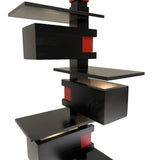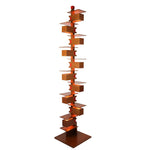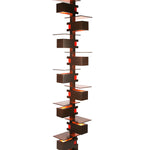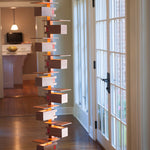















Taliesin 2 Floor Lamp
- Description
- Details
- Shipping
- Returns
Frank Lloyd Wright (1867-1959) is recognized world-wide as one of the greatest architects of the twentieth century. His work heralded a new thinking in architecture, using innovation in design and engineering made possible by newly developed technology and materials. His creative ability extended far beyond the border of architecture to graphic design, furniture, art glass, textiles, and decorative elements for the home.
In 1933, when Frank Lloyd Wright converted the original gymnasium of his Hillside Home School, located in Spring Green, Wisconsin, into a theater, he designed lighting pendants composed of rectangular light boxes and plywood shields to be suspended from the tall ceiling. These fixtures proved to be a lighting innovation, providing comfortable indirect light without the use of glass or shades. In 1952, when the theater was rebuilt following a fire, Wright modified the design of the original fixtures for use in the dining room, attaching them to the oak beam overhead. He found their soft indirect light so pleasing that he had a standing floor lamp of the same design fabricated for use in his own home, Taliesin.
This item is handcrafted and made-to-order. Please allow 10-12 weeks for production and delivery.
⋅Measures 16"W x 16"D x 80"H
⋅Weighs 28 lbs
⋅Some assembly required, instructions included
⋅(10) 15W incandescent bulbs pre-installed
⋅On/off foot switch included
⋅Only available in the USA
⋅Made in the USA
Shipping is included for all special order items within the continental United States.
Please contact us if you would like to ship to other locations outside of the continental United States. If eligible, we will confirm availability and associated shipping costs.
Special Order items are final sale and non-returnable.
SPECIAL ORDER
This item is special order. Shipping is included for all special order items within the continental United States.
Please contact us if you would like to ship to other locations outside of the continental United States. If eligible, we will confirm availability and associated shipping costs.
Please note that all special order items are final sale and non-returnable.
Each purchase supports the Frank Lloyd Wright Foundation’s mission to inspire people to discover and embrace an architecture for better living through meaningful connections to nature, the arts, and each other.
- Related products
- Recently viewed











